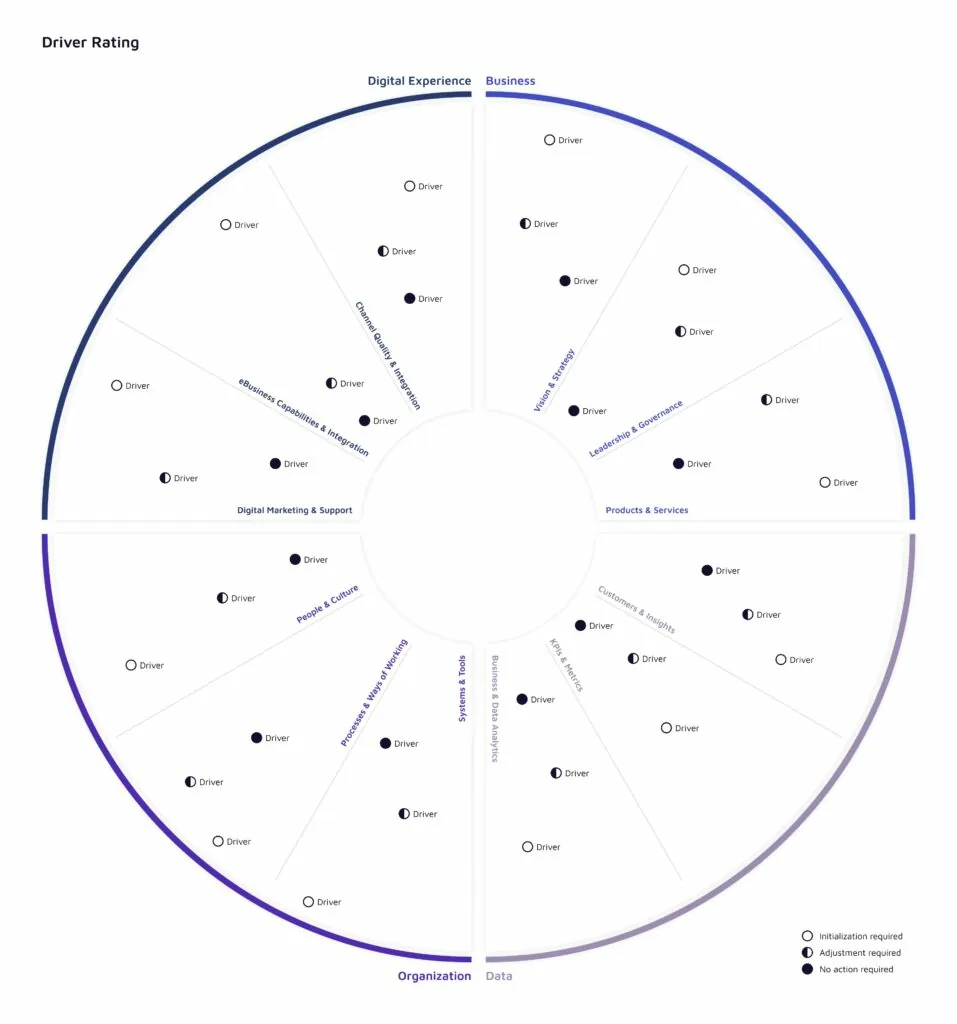Highlight

Successful together – our valantic Team.
Meet the people who bring passion and accountability to driving success at valantic.
Get to know usDecember 18, 2023

In Part I of this article, we have already explored why customer centricity is so important and why you should up your CX game. Customer experience encompasses all the unique customer perceptions and interactions with a company across various touchpoints throughout the entire customer lifecycle.
Every company possesses a distinct level of CX maturity, with many falling into the category of being relatively immature. Interestingly, this immaturity presents an opportunity for growth and improvement. Let’s explore the possibilities!

Our approach draws from a four-stage classification system initially developed by Robert G. Thompson1 to delineate and evaluate the various maturity levels:
At this stage, the primary goal is to increase product and service sales to the most valuable customers. The primary focus lies in the identification and targeting of high-value customers to optimize sales and revenue. In level 1, the digital experience platform (DXP) is geared toward prioritizing micro-moments and improving interactions through various features.
From a business and organizational standpoint, level 1 is characterized by ad-hoc efforts driven by business priorities and a product-centered approach. The organizational structure may be relatively static, emphasizing traditional business practices. Descriptive data analysis plays a key role in assessing customer purchase patterns.
In level 2, the emphasis shifts towards customer feedback and improvement based on their input. The primary goal is to be highly responsive to customer needs and concerns, ultimately ensuring their satisfaction and fostering loyalty. Within this stage, the DXP strives to unify functions and channels within a well-defined customer journey, offering a seamless and consistent experience.
Reaching level 2 maturity requires a shift in business and organizational design towards customer-situational awareness. This involves developing a keen understanding of the context in which customers engage with the company and the subsequent adaptation of business processes. Moreover, domain-specific diagnostic analytics come to the forefront, facilitating a deeper understanding of distinct customer segments and their pain points throughout their journey.
Level 3 is all about creating a deep emotional connection that drives advocacy behavior. The primary objective is to nurture strong relationships between the organization and its customers, leading to enthusiastic support and positive word-of-mouth. Within this stage, the goal of the DXP is to facilitate seamless interactions between digital and analog channels, ensuring a comprehensive and unified customer experience.
From a business and organizational perspective, level 3 places a strong emphasis on anticipation. The organization proactively anticipates customer needs and desires, striving to exceed their expectations. The structure becomes more agile, enabling faster decision-making and adaptability in response to evolving customer needs. Predictive analytics assumes a pivotal role in comprehending customer behavior patterns and preferences, enabling personalized offerings and timely (“one-to-one”) interventions.
In level 4, the primary objective is to proactively develop innovative solutions to address customer needs before they even express them. The organization transitions to a profoundly customer-centric approach, utilizing customer insights to fuel innovation and craft extraordinary experiences. Regarding the DXP, the aim is to create highly personalized customer journeys, tailoring interactions and offerings to individual wishes and requirements.
At level 4, the business and organizational design fully embodies customer-centricity and agility. The organization structures its processes, systems and frameworks around the customer, ensuring a seamless and effortless experience at every touchpoint. Leadership with a customer focus becomes pivotal, empowering employees to make decisions that prioritize customer satisfaction. Automated processes streamline operations and enhance the efficiency of customer services. Additionally, prescriptive analytics is leveraged to provide actionable recommendations, guiding decision-making and perpetuating a cycle of continuous improvement.
Assessing a company’s specific maturity level also involves evaluating it across four distinct dimensions. The assessment primarily centers on the holistic digital experience. Given the evolving landscape of customer needs, the impact of the mobile-first generation and the rapid advancements in technology, digital channels have become paramount in today’s business environment.
Furthermore, there are three key dimensions that facilitate an exceptional digital experience: business, organization and data. Each of these four dimensions has been subdivided into specific and relevant capability areas. Let’s delve a bit deeper into these four dimensions and their corresponding capability areas.
The primary dimension, known as the digital experience dimension, closely examines several key aspects. These include the setup, integration and quality of your channels, which form the foundation of the overall customer experience. Additionally, it assesses your e-commerce capabilities, focusing on your ability to sell products and services. Beyond that, valantic also analyzes your digital marketing and support capabilities, as they are vital for attracting, assisting, and retaining customers.
The enabling dimensions encompass three critical areas:
Within each of the aforementioned capability areas, we have pinpointed the primary drivers, which serve as the mechanisms that can be adjusted, the actions that can be taken, the levers that can be pulled, and the areas where a company can focus to excel in the respective capability area.
During the maturity assessment, these drivers will be initially examined from a subject-specific perspective, allowing us to gain insight into the company’s current maturity level within each capability area. Subsequently, all these drivers can be evaluated and rated based on their urgency for action in order to attain the desired level of maturity.

The value derived from this assessment process is significant. As previously mentioned, when you assess your current customer-centric efforts across all dimensions, you gain a comprehensive yet easily understandable overview. This enables a profound insight into your company’s current state regarding the creation and facilitation of the best possible customer experiences.
With a clear understanding of which drivers require immediate attention, we prioritize them and establish concrete, measurable actions for each of these drivers. The defined actions can then be transformed into initiatives, organized within a time sequence, and any interdependencies can be highlighted. This consolidated information serves as the foundation for setting up a transformation program.
Following the assessment, you will possess a high-level blueprint for your customer experience transformation, tailored to your company’s execution capabilities.
Up your CX game with us now!
This approach sounds like exactly the right fit for you? Then we encourage you to reach out and embark on the journey towards becoming a CX champ!
1Thompson, R. (2013, January 28). Listening to the Voice of Customers: Can You Answer These 5 Key Questions?. CustomerThink. Listening to the Voice of Customers: Can You Answer These 5 Key Questions?
Don't miss a thing.
Subscribe to our latest blog articles.